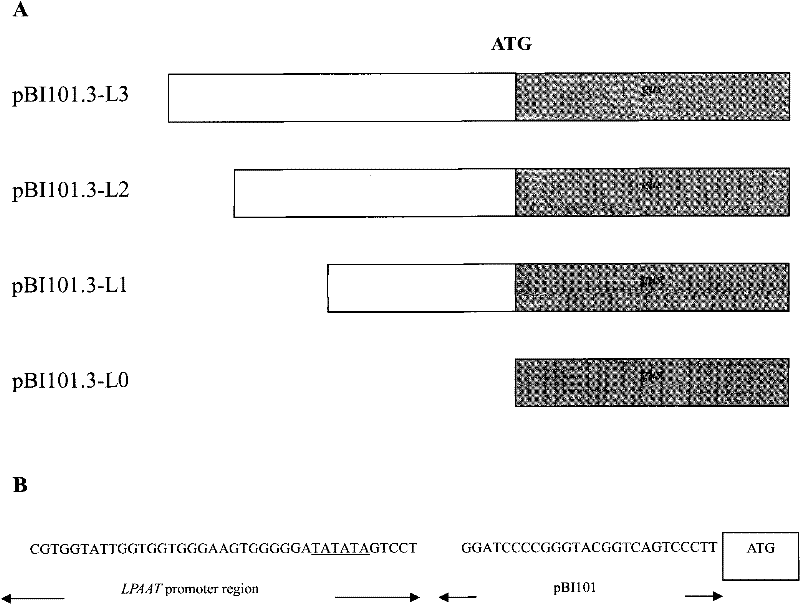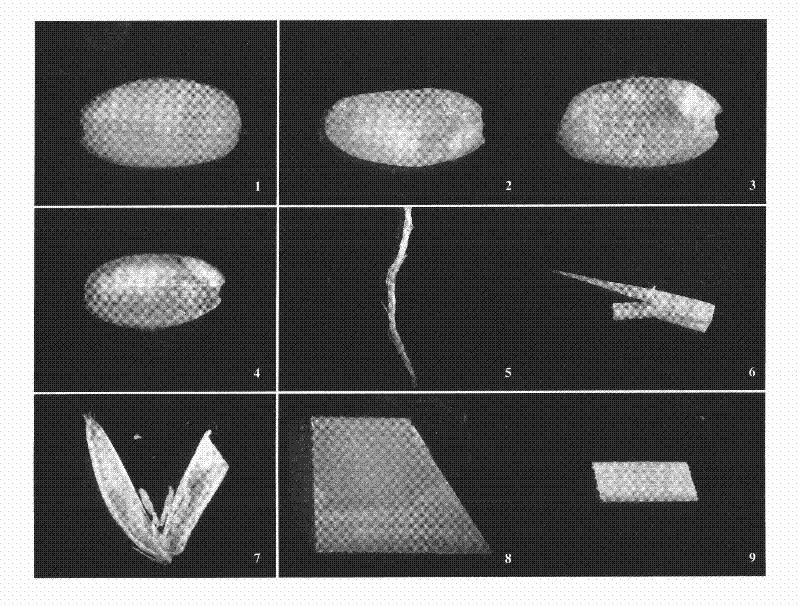Application of gene promoter region sequence of glycerophospholipid peptidy transeferace in crop genetic improvement
A gene promoter region, glycerol phosphate acyl technology, applied in the direction of plant gene improvement, application, genetic engineering, etc., can solve the problems of inability to store organs - seed modification and improvement, neglect, limited promoter types, etc., to achieve high Stability and operability effects
- Summary
- Abstract
- Description
- Claims
- Application Information
AI Technical Summary
Problems solved by technology
Method used
Image
Examples
Embodiment 1
[0029] Example 1 Extraction of coconut genomic DNA
[0030] High-quality coconut genomic DNA was extracted from young leaves by the CTAB method. After the material is ground in liquid nitrogen, take 0.1g and add 600μL of CTAB extract (containing 4% β-mercaptoethanol), continue to grind to make it evenly suspended, place in 65℃ water bath for 45min; add 700μL of phenol:chloroform:isoamyl alcohol, 37℃ water bath Warm bath for 10 minutes. Centrifuge at 12000rpm for 10min; take the supernatant, add 60μL 5M NaCl, 1mL frozen absolute ethanol, freeze for 30min to precipitate DNA; centrifuge at 10000rpm for 5min, discard the alcohol and air dry. Add TE to the air-dried DNA, water bath at 37°C for 15-30min until the DNA is completely dissolved, add 700μL of chloroform: isoamyl alcohol (24:1), invert for 15min, centrifuge at 12000rpm for 5min; take the supernatant, add 30μL of 5M NaCl, 1mL freeze Precipitate with absolute ethanol at -20°C for 30 min, centrifuge at 10000 rpm for 3 min, di...
Embodiment 2
[0031] Example 2 Cloning and analysis of the upstream promoter sequence of LPAAT gene
[0032] The cloning of the upstream promoter sequence of the glycerophosphate acyltransferase gene was performed according to the operating manual of the Universal GenomeWalker Kit (Clontech). Genomic DNA was first digested with 4 blunt-end endonucleases (EcoRI, Pvu II, Dra I, Stu I). The digested product is purified and ligated with a specific linker. The ligated product is used in the first round of nested PCR reaction. The nucleotide sequence of the specific primer for the glycerophosphate acyltransferase gene is shown in SEQ ID NO: 2. The linker specific primer The nucleotide sequence is shown in SEQ ID NO:3. The PCR reaction program is: 94°C for 25s, 72°C for 3min, 7 cycles: 94°C for 25s, 67°C for 3min, 32 cycles; 67°C for 7min. In the second round of PCR, the product of the first round of PCR reaction was used as the substrate, and the same amplification procedure was applied. The nucle...
Embodiment 3
[0033] Example 3 Construction and genetic transformation of plant expression vectors
[0034] In order to verify the effect of the obtained promoter region sequence in tissue-specific expression control, three different types of promoter fragments deleted at the 5'end were used in the construction of plant expression vectors. The deletion fragments were inserted into the promoter verification expression vector pBI101.3, respectively named pBI101.3-L3, pBI101.3-L2, pBI101.3-L1. The 3 fragment deletion sites were -896, -817 and- 453. Both ends of the PCR amplification primers were added with 8-base restriction sites HindIII and BamHI. The relevant primer sequences are:
[0035] The nucleotide sequence of p101-1L is shown in SEQ ID NO: 6;
[0036] The nucleotide sequence of p101-2L is shown in SEQ ID NO: 7;
[0037] The nucleotide sequence of p101-3L is shown in SEQ ID NO: 8;
[0038] The nucleotide sequence of p101-R is shown in SEQ ID NO:9.
[0039] After the amplified product was rec...
PUM
 Login to View More
Login to View More Abstract
Description
Claims
Application Information
 Login to View More
Login to View More - R&D
- Intellectual Property
- Life Sciences
- Materials
- Tech Scout
- Unparalleled Data Quality
- Higher Quality Content
- 60% Fewer Hallucinations
Browse by: Latest US Patents, China's latest patents, Technical Efficacy Thesaurus, Application Domain, Technology Topic, Popular Technical Reports.
© 2025 PatSnap. All rights reserved.Legal|Privacy policy|Modern Slavery Act Transparency Statement|Sitemap|About US| Contact US: help@patsnap.com



